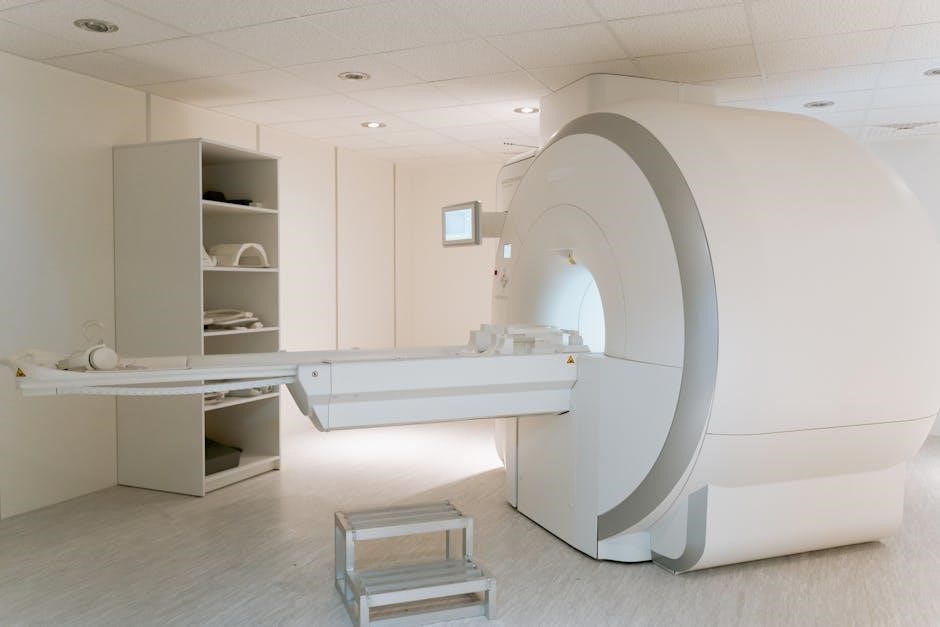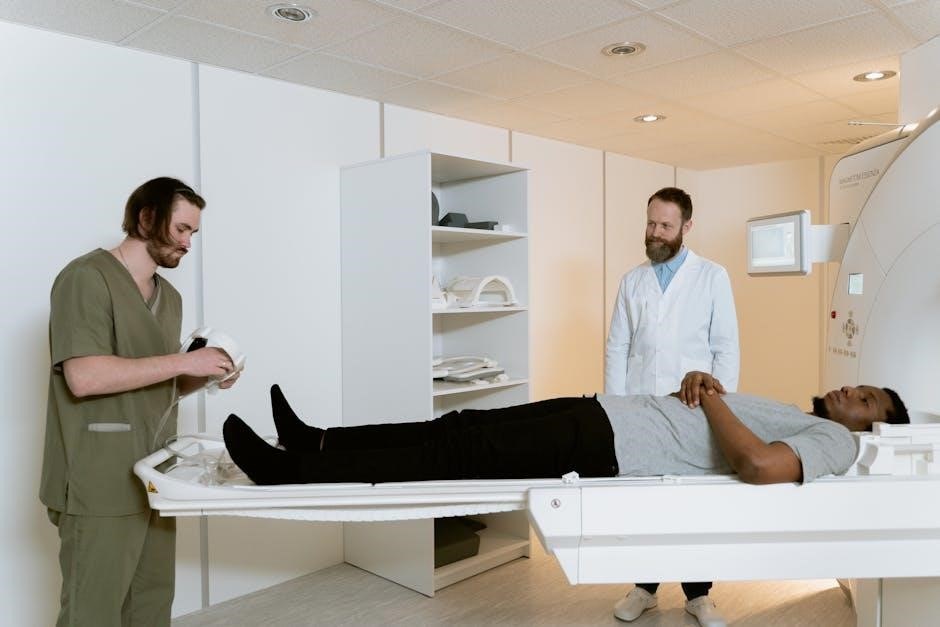The BOT-2 Assessment is a standardized tool evaluating motor proficiency in children‚ focusing on fine and gross motor skills‚ balance‚ and coordination‚ aiding in identifying developmental needs.
Overview of the BOT-2 Assessment
The BOT-2 is a standardized assessment tool designed to evaluate motor proficiency in children and young adults aged 4-21. It focuses on fine motor skills‚ gross motor skills‚ balance‚ and coordination. The test consists of eight subtests that measure various aspects of motor function‚ providing a comprehensive understanding of an individual’s motor abilities. Widely used in educational and clinical settings‚ the BOT-2 helps identify developmental delays‚ strengths‚ and areas requiring intervention. Its structured format ensures reliable and accurate results‚ making it a valuable resource for professionals working with children.
Purpose and Significance of the BOT-2
The BOT-2 is designed to evaluate motor proficiency in children and young adults‚ providing insights into their fine motor‚ gross motor‚ and coordination abilities. Its primary purpose is to identify motor skill strengths and challenges‚ aiding in early detection of developmental delays. This assessment is significant for creating personalized intervention plans‚ guiding educational and therapeutic strategies. By measuring motor abilities‚ the BOT-2 supports informed decision-making‚ helping professionals develop targeted programs to enhance motor development and overall functional performance in individuals.
Structure and Components of the BOT-2
The BOT-2 assessment is divided into four main sections: Fine Motor‚ Gross Motor‚ Coordination‚ and Balance. Each section contains specific subtests that evaluate different motor skills‚ such as drawing‚ tracing‚ and using small objects for fine motor‚ and running‚ jumping‚ and balancing for gross motor. The assessment also includes a detailed manual with instructions and scoring guidelines. Additionally‚ the BOT-2 is available in a convenient PDF format‚ which includes all necessary tools and resources for accurate administration and scoring.

Preparing for the BOT-2 Assessment
Preparing for the BOT-2 involves understanding the scoring manual‚ setting up a suitable environment‚ and ensuring clients are ready. The PDF version aids in convenient preparation and administration.
Understanding the BOT-2 Scoring Manual
The BOT-2 scoring manual is essential for accurate assessment administration. It provides detailed instructions for calculating raw scores‚ converting them to scale scores‚ and interpreting results. The manual outlines age-based norms‚ allowing for meaningful comparisons. Administrators must familiarize themselves with scoring criteria‚ including how to handle incomplete items or refusal to attempt tasks. The PDF version of the manual ensures easy access and portability. Proper understanding of scoring procedures is critical for reliable results and valid interpretations of motor skills. Regular review of the manual ensures consistency in administration and scoring.
Setting Up the Assessment Environment
Creating an appropriate environment is crucial for effective BOT-2 administration. Ensure a quiet‚ well-lit‚ and distraction-free space with sufficient room for movement. Arrange seating to allow clear observation of the client’s performance. Use a sturdy‚ flat surface for manipulative tasks and ensure all materials are organized and within reach. Minimize interruptions by informing others of the testing schedule. Familiarize yourself with the BOT-2 PDF to streamline the process. A well-prepared environment ensures client comfort and accurate assessment outcomes‚ fostering reliable results and valid interpretations of motor skills.
Pre-Assessment Preparation for Clients
Pre-assessment preparation for clients is essential to ensure their readiness and comfort. Inform clients about the purpose and duration of the BOT-2 assessment to reduce anxiety. Encourage wearing comfortable clothing for ease of movement. Ensure clients are well-rested and hydrated. Review any specific instructions or materials provided in the BOT-2 PDF to familiarize them with the process. Address any questions or concerns to promote a positive experience. Proper preparation helps clients perform at their best‚ yielding accurate and reliable results for effective motor skills evaluation.

Administering the BOT-2 Assessment
Administering the BOT-2 involves guiding clients through structured subtests‚ ensuring clear instructions‚ and maintaining engagement to accurately assess motor skills.
Step-by-Step Administration Guidelines
Begin by preparing all materials and ensuring the environment is distraction-free. Review the BOT-2 manual to familiarize yourself with subtests. Provide clear‚ concise instructions to the client‚ demonstrating tasks when necessary. Allow practice trials to ensure understanding. Administer subtests in the recommended order‚ scoring immediately to avoid errors. Ensure the client is comfortable and engaged throughout. Use theBOT-2 PDF for easy access to instructions and scoring guides. Maintain consistency in administration to ensure reliability and accuracy in results.
Subtest Instructions and Procedures
The BOT-2 assessment includes specific instructions for each subtest to ensure accuracy. Begin with fine motor tasks like drawing shapes and folding paper‚ using standardized materials. Gross motor subtests involve activities such as running and jumping‚ requiring clear demonstrations. Coordination tasks‚ like catching a ball‚ must be timed and scored precisely. Balance subtests‚ such as standing on one leg‚ should be administered on a flat surface. Follow the BOT-2 PDF guidelines for setup‚ scoring‚ and client instructions to maintain consistency and reliability across all subtests.
Handling Special Cases and Challenges
When administering the BOT-2‚ challenges may arise with clients who have physical disabilities or anxiety. Use assistive devices for clients with motor impairments‚ and provide additional time for tasks if needed. For anxious clients‚ ensure a calm environment and offer breaks. Maintain standardized administration to uphold test integrity. Follow the BOT-2 PDF guidelines for accommodations and modifications. Proper training and experience are essential for handling such cases effectively and ensuring accurate results.

Scoring the BOT-2 Assessment
Scoring the BOT-2 involves calculating raw scores‚ converting them to scale scores‚ and comparing results to normative data to assess motor skills effectively.
Calculating Raw Scores and Scale Scores
Calculate raw scores by summing correct responses for each subtest. Convert raw scores to scale scores using the BOT-2 manual‚ ensuring standardization. Scale scores are normalized‚ allowing comparison to peers. This process ensures accurate measurement of motor skills. Proper calculation is crucial for valid results. Always follow manual guidelines to avoid errors. Accurate scoring is essential for identifying strengths‚ weaknesses‚ and planning interventions. This step ensures reliable data for informed decision-making in educational and clinical settings. Adhere to scoring rules for consistency and validity in assessment outcomes.
Interpreting Subtest and Composite Scores
Interpret subtest scores to identify specific motor skill strengths and weaknesses. Composite scores provide an overall measure of motor proficiency. Compare scores to age-based norms to determine if performance is average‚ above‚ or below expectations. Analyze score patterns to inform clinical or educational decisions. Consider the individual’s background and testing conditions when interpreting results. This step helps in creating targeted intervention plans. Accurate interpretation ensures effective use of assessment data for supporting client needs and progress monitoring.
Using Normative Data for Comparison
Normative data provides a baseline for comparing an individual’s performance to peers of the same age. This data helps identify if motor skills are average‚ above‚ or below expectations. By referencing normative scores‚ administrators can detect delays or exceptional abilities. This comparison aids in diagnosis‚ intervention planning‚ and progress monitoring. Normative data ensures results are interpreted within a standardized framework‚ enhancing the reliability of assessments. It is essential for making informed decisions about motor skill development and support strategies.
Interpreting BOT-2 Results
Understanding BOT-2 results helps identify motor skill strengths‚ weaknesses‚ and developmental needs. Accurate interpretation guides targeted interventions and supports individualized planning for clients of all ages.
Understanding Score Interpretation
Interpreting BOT-2 scores involves analyzing raw‚ scale‚ and composite scores to determine motor skill proficiency. Scores are compared to normative data to identify typical or atypical performance. Understanding score interpretation allows clinicians to pinpoint strengths‚ weaknesses‚ and developmental delays. It also guides the creation of targeted interventions and monitors progress over time; Accurate interpretation requires considering the client’s age‚ abilities‚ and any disabilities. This process ensures meaningful insights into motor skills‚ supporting informed decision-making for therapy or educational planning. Effective interpretation is key to maximizing the assessment’s benefits for clients.
Identifying Strengths and Weaknesses
The BOT-2 assessment provides a detailed profile of motor skills‚ enabling clinicians to identify areas of strength and weakness. By analyzing subtest scores‚ professionals can pinpoint specific abilities‚ such as fine motor precision or balance‚ where the individual excels or struggles. This helps in creating focused interventions and tracking progress. Weaknesses may indicate developmental delays or motor skill deficits‚ while strengths highlight areas of competence. This targeted approach ensures personalized support‚ addressing unique needs effectively and fostering overall motor development.
Developing Intervention Strategies
Based on BOT-2 results‚ tailored intervention strategies are created to address specific motor skill deficits. The assessment’s comprehensive data helps identify priority areas‚ such as fine motor‚ balance‚ or coordination. Clinicians design targeted activities‚ incorporating adaptive equipment and exercises to enhance skill development. Interventions may include structured practice‚ sensory integration techniques‚ or functional adaptations to improve daily performance. Regular monitoring and adjustments ensure progress‚ fostering meaningful improvements in motor abilities and overall functional independence.

Applications of the BOT-2 Assessment
The BOT-2 assessment is widely used in educational‚ clinical‚ and therapeutic settings to evaluate motor skills‚ guide intervention planning‚ and monitor progress in children and adolescents.
Use in Educational Settings
The BOT-2 assessment is widely utilized in schools to identify motor skill deficits in students‚ informing individualized education programs (IEPs) and 504 plans. Educators use the assessment to evaluate fine motor‚ gross motor‚ and visual-motor skills‚ helping to create targeted intervention strategies. The BOT-2 PDF format allows easy access to test materials and scoring guides‚ enabling school psychologists and occupational therapists to efficiently assess and support students. By addressing motor challenges‚ educators can improve academic performance and overall student success. The assessment also aids in progress monitoring and intervention planning within educational environments.
Role in Clinical and Therapeutic Practices
The BOT-2 assessment is integral in clinical and therapeutic settings‚ aiding professionals like occupational and physical therapists to evaluate motor skills. It helps identify deficits in fine motor‚ gross motor‚ and visual-motor abilities‚ guiding precise diagnoses and treatment plans. The BOT-2 PDF enhances accessibility‚ enabling efficient administration and scoring. Clinicians rely on it to monitor progress and adjust interventions‚ making it a vital tool for improving motor function and patient outcomes in therapeutic environments.
Application in Research and Progress Monitoring
The BOT-2 assessment is widely used in research to study motor skill development and impairments. Its standardized format ensures reliability in longitudinal studies and clinical trials. Researchers leverage the BOT-2 PDF for consistent administration and data collection. It also serves as a tool for progress monitoring‚ allowing clinicians to track changes in motor abilities over time. This makes it invaluable for evaluating intervention effectiveness and informing evidence-based practices in both research and therapeutic contexts.

BOT-2 Assessment Tools and Resources
The BOT-2 assessment provides a comprehensive kit with manuals‚ scoring guides‚ and stimuli for accurate administration. The BOT-2 PDF offers convenience for digital access and printing.
Overview of the BOT-2 Kit Components
The BOT-2 kit includes essential tools for administration‚ such as the Examiner’s Manual‚ Test Record Forms‚ and a Stimulus Book with visual aids. Manipulatives like blocks‚ pegs‚ and balance beams are also provided. The kit is complemented by a Scoring Summary Form and Normative Data Manual for accurate interpretation. Additionally‚ the BOT-2 PDF version offers digital access to these materials‚ allowing for easy printing and organization. This comprehensive collection ensures administrators have everything needed to conduct and score the assessment efficiently‚ whether in-person or remotely.
Using the BOT-2 PDF for Convenience
The BOT-2 PDF version offers flexibility and accessibility‚ allowing administrators to easily access test materials digitally. It includes the Examiner’s Manual‚ Test Record Forms‚ and Stimulus Book in a downloadable format. This convenient option enables printing of specific sections as needed‚ reducing clutter and saving time. The PDF is ideal for remote assessments‚ as it can be shared electronically. Additionally‚ digital tools like search functions and zoom capabilities enhance usability. This format ensures administrators can efficiently prepare and conduct assessments without relying on physical materials‚ streamlining the process.
Additional Resources for Administrators
Beyond the BOT-2 PDF‚ administrators can access supplementary materials to enhance assessment practices. These include training workshops‚ online webinars‚ and detailed scoring guides. The Examiner’s Manual provides comprehensive instructions‚ while practice test forms help familiarize administrators with the assessment structure. Additional resources like scoring templates and interpretation guides ensure accuracy. These tools support effective administration and interpretation‚ making the BOT-2 assessment more user-friendly and reliable for evaluators. They are essential for maximizing the utility of the BOT-2 in various settings.

Comparing BOT-2 with Other Assessments
The BOT-2 is compared to other motor assessments‚ emphasizing its comprehensive evaluation of skills and its role in clinical and educational settings for precise and reliable outcomes.
Key Differences Between BOT-2 and BOT-3
The BOT-2 and BOT-3 differ primarily in their age ranges and assessment focus. The BOT-2 is designed for individuals aged 4 to 21‚ while the BOT-3 includes younger children starting from birth. The BOT-2 places greater emphasis on fine and gross motor skills‚ with detailed subtests for precise evaluation. In contrast‚ the BOT-3 integrates sensory and motor components‚ offering a more comprehensive developmental assessment. The scoring systems also vary‚ with BOT-2 providing deeper analysis of motor proficiency‚ whereas BOT-3 includes additional scales for sensory processing and emotional regulation.
Comparison with Other Motor Skill Assessments
The BOT-2 stands out among other motor skill assessments due to its comprehensive evaluation of fine and gross motor abilities. Unlike some tools that focus solely on gross motor skills‚ the BOT-2 includes detailed subtests for fine motor precision and dexterity. Its standardized scoring system ensures reliability‚ making it a preferred choice in clinical and educational settings. Additionally‚ the BOT-2’s user-friendly design and clear instructions facilitate accurate administration. It is also widely used for progress monitoring‚ offering actionable insights for intervention planning.
Unique Features of the BOT-2
The BOT-2 is distinguished by its comprehensive assessment of motor skills‚ combining both fine and gross motor tasks in one tool. It offers detailed subtests‚ such as fine motor precision and bilateral coordination‚ providing a holistic view of motor abilities. The BOT-2 also includes a unique scoring system that allows for precise tracking of progress over time. Its user-friendly design and clear instructions make it accessible for administrators across various settings. These features enhance its utility in identifying motor skill deficits and guiding targeted interventions‚ making it a valuable resource for clinicians and educators alike.

Best Practices for BOT-2 Administration
Adhere to standardized guidelines‚ ensure a distraction-free environment‚ and verify client readiness. Accurately follow test instructions and scoring criteria to maintain reliability and validity in results.
Ensuring Accuracy and Reliability
To ensure accuracy and reliability in BOT-2 administration‚ follow standardized testing protocols and use the official BOT-2 assessment PDF materials. Properly train administrators to minimize scoring errors and maintain consistency across test sessions. Ensure clients understand instructions clearly and provide necessary accommodations. Use the correct tools and materials‚ and maintain a quiet‚ distraction-free environment. Adhere strictly to the test manual’s guidelines for administration and scoring to ensure valid and reliable results. Regularly review and update administrators’ training to reflect best practices and updates in the assessment protocol.
- Use officialBOT-2 materials consistently.
- Ensure administrators are well-trained.
- Maintain a controlled testing environment.
- Adhere to scoring guidelines precisely.
Minimizing Errors in Scoring and Interpretation
To minimize errors in scoring and interpretation of the BOT-2 assessment‚ ensure meticulous attention to detail and adherence to the official BOT-2 assessment PDF guidelines. Double-check raw scores against the scoring manual‚ and verify subtest totals before calculating composite scores. Avoid interpretation biases by relying on normative data and standardized scoring criteria. Regularly review test administration videos or protocols to identify and correct potential errors. Use the provided scoring templates to reduce calculation mistakes and ensure consistency across evaluations.
- Double-check scores against guidelines.
- Use standardized scoring templates.
- Review administration protocols for accuracy.
- Rely on normative data for fair interpretation.
Maintaining Test Security and Integrity
Maintaining the security and integrity of the BOT-2 assessment is crucial to ensure valid and reliable results. Store the BOT-2 assessment PDF and physical materials in a secure‚ accessible location‚ and limit access to authorized personnel only. Ensure test materials are not shared or reproduced without permission. During administration‚ prevent unauthorized individuals from observing or interacting with the process. After testing‚ securely store all materials and ensure digital copies are password-protected. Adhere to publisher guidelines to uphold the assessment’s integrity and confidentiality.
- Securely store all test materials.
- Limit access to authorized personnel.
- Prevent unauthorized observation or reproduction.
- Follow publisher guidelines rigorously.

Telehealth and Remote BOT-2 Administration
The BOT-2 assessment PDF facilitates telehealth administration‚ enabling remote evaluation of motor skills. Ensure stable internet‚ clear audiovisual setups‚ and proper testing environments for accurate results.
Guidelines for Remote Testing
When administering the BOT-2 remotely‚ ensure a stable internet connection and proper audiovisual setup. Use the BOT-2 assessment PDF to maintain test integrity. Ensure the client’s environment is quiet and free from distractions. Conduct a pre-test check to verify device functionality and test security. Administrators should be trained in digital tools to accurately score and interpret results; Use secure platforms for data transmission and storage. Ensure clear communication with clients‚ providing detailed instructions. Use digital timers for accuracy and maintain test protocols to ensure reliability. Regularly update software and devices for optimal performance.
Best Practices for Virtual Assessments
For effective virtual administration of the BOT-2 assessment‚ ensure clients are well-prepared and understand instructions clearly. Utilize the BOT-2 assessment PDF to maintain consistency and accessibility. Ensure a stable internet connection and proper device setup to prevent interruptions. Maintain engagement through clear communication and minimize environmental distractions. Use digital tools for accurate scoring and documentation. Regularly review and update virtual assessment protocols to align with best practices. Ensuring these elements will help maintain the reliability and validity of the assessment results.
Challenges and Solutions in Remote Testing
Remote BOT-2 testing presents challenges like technical difficulties‚ environmental distractions‚ and ensuring test security. To address these‚ use reliable internet connections and backup devices. Minimize distractions by creating a quiet‚ clutter-free space. Ensure test integrity by monitoring the environment and using encrypted platforms. For motor skill assessments‚ utilize high-quality cameras for clear observation. Provide clear instructions and demonstrate tasks virtually to ensure understanding. Regularly test equipment beforehand to avoid disruptions. These strategies help maintain the validity and reliability of remote BOT-2 assessments while addressing potential obstacles effectively.

Case Studies and Practical Examples
The BOT-2 assessment has been effectively used in schools and clinics to evaluate motor skills‚ providing insights for targeted interventions and improved outcomes in real-world scenarios.
Real-World Applications of the BOT-2
The BOT-2 assessment has been widely used in schools and clinical settings to evaluate motor skills in children. For instance‚ it has helped identify motor delays in early childhood‚ guiding targeted interventions. In educational settings‚ the BOT-2 PDF has been utilized to monitor progress in motor skill development among students with special needs. Clinicians also rely on it to assess fine and gross motor abilities‚ informing therapy plans. Its practical applications extend to research‚ where it has been used to study motor skill trends and outcomes in various populations. The BOT-2’s versatility makes it a valuable tool across diverse settings.
Success Stories and Outcomes
The BOT-2 assessment has yielded positive outcomes in identifying and addressing motor skill challenges. Many children have shown significant improvement in fine and gross motor abilities after targeted interventions based on BOT-2 results. Educators and therapists report enhanced functional skills‚ leading to better academic performance and daily living activities. For instance‚ a child with motor delays achieved age-appropriate skills after therapy guided by BOT-2 insights. Such success stories highlight the tool’s effectiveness in fostering meaningful progress and confidence in children with motor difficulties.
Lessons Learned from Administration
Administering the BOT-2 assessment has provided valuable insights into optimizing its use. Understanding the test structure and scoring nuances is crucial for accurate results. Ensuring a calm and focused environment helps children perform at their best. Clear communication of instructions and demonstrating tasks effectively minimizes confusion. Additionally‚ being prepared for diverse client needs‚ such as accommodating physical limitations‚ enhances the assessment process. These lessons emphasize the importance of thorough preparation and adaptability‚ leading to more reliable and meaningful outcomes for children.
Future Directions and Updates
The BOT-2 assessment may see updates to enhance digital accessibility‚ improve scoring tools‚ and align with emerging research in motor skills development for better user experiences.
Expected Revisions and Enhancements
Future updates to the BOT-2 assessment may include digital enhancements‚ such as an online scoring platform‚ to improve efficiency. The PDF format could be optimized for mobile devices‚ ensuring accessibility. Revisions may also focus on updating normative data and expanding age ranges. New subtests or modified instructions could address emerging motor skill assessment needs. Feedback from clinicians and educators will likely guide these changes‚ ensuring the BOT-2 remains a reliable and comprehensive tool for evaluating motor skills in diverse populations.
Emerging Trends in Motor Skill Assessment
Emerging trends in motor skill assessment emphasize technology integration‚ such as motion sensors and AI-driven tools‚ to enhance accuracy. There is a growing focus on inclusive assessments for diverse populations‚ including those with varying abilities. Remote and telehealth-based evaluations are gaining traction‚ aligning with the BOT-2 PDF’s convenience. Additionally‚ there is a shift toward integrating motor skills with cognitive and emotional assessments for a holistic evaluation approach. These trends aim to make assessments more accessible‚ efficient‚ and comprehensive while maintaining reliability and validity.
The Role of Technology in Future Assessments
Technology is poised to revolutionize motor skill assessments like the BOT-2. Digital platforms and AI-driven tools can enhance precision in scoring and analysis. Virtual reality (VR) and augmented reality (AR) may offer immersive testing environments. Automated scoring systems can reduce human error‚ while real-time data sharing facilitates collaboration among professionals. Telehealth integration‚ as seen with the BOT-2 PDF‚ ensures accessibility. These advancements aim to streamline administration‚ improve accuracy‚ and expand the reach of motor skill assessments‚ making them more efficient and accessible for diverse populations.